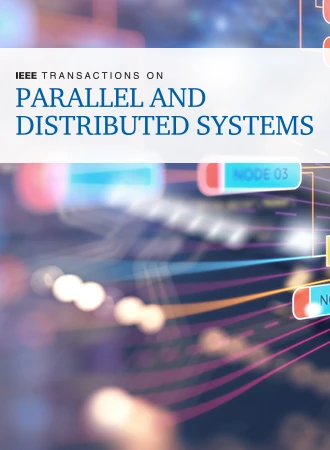A Multidimensional Communication Scheduling Method for Hybrid Parallel DNN Training
IF 5.6
2区 计算机科学
Q1 COMPUTER SCIENCE, THEORY & METHODS
IEEE Transactions on Parallel and Distributed Systems
Pub Date : 2024-03-28
DOI:10.1109/TPDS.2024.3406420
引用次数: 0
Abstract
The transformer-based deep neural network (DNN) models have shown considerable success across diverse tasks, prompting widespread adoption of distributed training methods such as data parallelism and pipeline parallelism. With the increasing parameter number, hybrid parallel training becomes imperative to scale training. The primary bottleneck in scaling remains the communication overhead. The communication scheduling technique, emphasizing the overlap of communication with computation, has demonstrated its benefits in scaling. However, most existing works focus on data parallelism, overlooking the nuances of hybrid parallel training. In this paper, we propose混合并行 DNN 训练的多维通信调度方法
基于变压器的深度神经网络(DNN)模型在各种任务中取得了相当大的成功,促使分布式训练方法(如数据并行和管道并行)得到广泛采用。随着参数数量的增加,混合并行训练成为扩展训练的当务之急。扩展的主要瓶颈仍然是通信开销。通信调度技术强调通信与计算的重叠,已经证明了其在扩展方面的优势。然而,现有的大多数工作都侧重于数据并行性,忽略了混合并行训练的细微差别。在本文中,我们提出了一个高效的通信调度框架 TriRace,用于在异步流水线并行和数据并行的混合并行训练中加速通信。为了实现有效的计算-通信重叠,TriRace 引入了三维通信调度,善于利用通信与计算之间的数据依赖关系,在混合并行训练中高效调度 AllReduce 通信、稀疏通信和点对点通信。为了避免可能出现的通信争议,TriRace 还采用了拓扑感知运行时,通过考虑正在进行的通信操作和实时网络状态来优化通信操作的执行。我们基于 PyTorch 和 Pipedream-2BW 实现了 TriRace 的原型,并用三个具有代表性的基线进行了综合评估。实验结果表明,与最先进的流水线并行性训练基线 Pipedream-2BW 相比,TriRace 实现了高达 1.07-1.45 倍的速度提升,与 Megatron 相比,实现了 1.24-1.81 倍的速度提升。
本文章由计算机程序翻译,如有差异,请以英文原文为准。
求助全文
约1分钟内获得全文
求助全文
来源期刊

IEEE Transactions on Parallel and Distributed Systems
工程技术-工程:电子与电气
CiteScore
11.00
自引率
9.40%
发文量
281
审稿时长
5.6 months
期刊介绍:
IEEE Transactions on Parallel and Distributed Systems (TPDS) is published monthly. It publishes a range of papers, comments on previously published papers, and survey articles that deal with the parallel and distributed systems research areas of current importance to our readers. Particular areas of interest include, but are not limited to:
a) Parallel and distributed algorithms, focusing on topics such as: models of computation; numerical, combinatorial, and data-intensive parallel algorithms, scalability of algorithms and data structures for parallel and distributed systems, communication and synchronization protocols, network algorithms, scheduling, and load balancing.
b) Applications of parallel and distributed computing, including computational and data-enabled science and engineering, big data applications, parallel crowd sourcing, large-scale social network analysis, management of big data, cloud and grid computing, scientific and biomedical applications, mobile computing, and cyber-physical systems.
c) Parallel and distributed architectures, including architectures for instruction-level and thread-level parallelism; design, analysis, implementation, fault resilience and performance measurements of multiple-processor systems; multicore processors, heterogeneous many-core systems; petascale and exascale systems designs; novel big data architectures; special purpose architectures, including graphics processors, signal processors, network processors, media accelerators, and other special purpose processors and accelerators; impact of technology on architecture; network and interconnect architectures; parallel I/O and storage systems; architecture of the memory hierarchy; power-efficient and green computing architectures; dependable architectures; and performance modeling and evaluation.
d) Parallel and distributed software, including parallel and multicore programming languages and compilers, runtime systems, operating systems, Internet computing and web services, resource management including green computing, middleware for grids, clouds, and data centers, libraries, performance modeling and evaluation, parallel programming paradigms, and programming environments and tools.
 求助内容:
求助内容: 应助结果提醒方式:
应助结果提醒方式:


